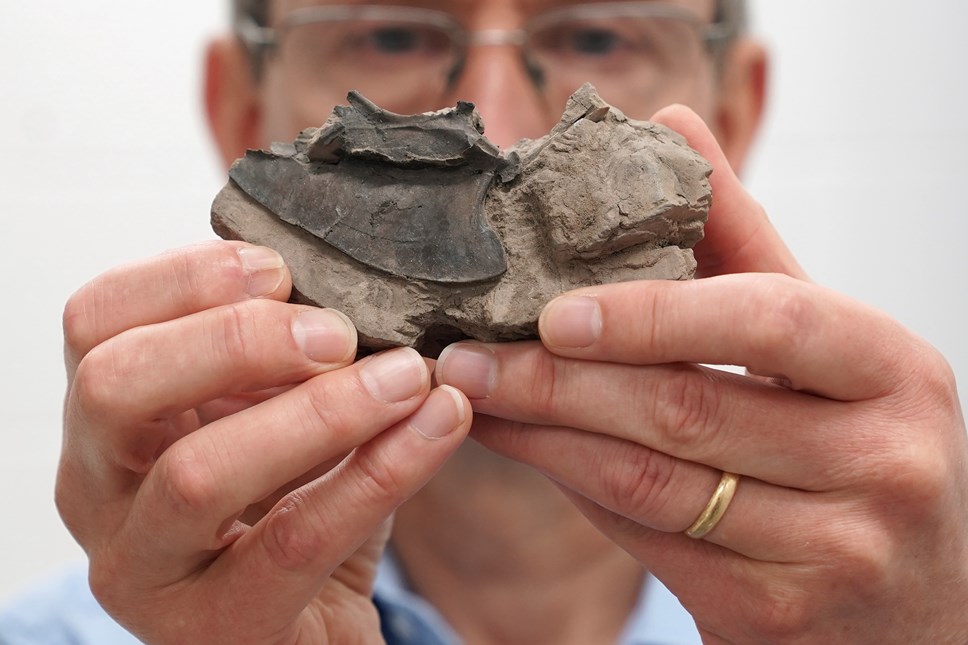
Fossil bird collection of international importance bequeathed to National Museums Scotland
Press images available here.
A collection of over 700 bird fossils has been bequeathed to National Museums Scotland. The fossils date from 54-56 million years ago, the beginning of the Eocene period, and represent the early stages in the evolution of modern birds. The collection is believed to contain many species which are new to science.
Work is now underway to fully document and describe the collection. Already two papers have been published describing new species, one being a falcon-like bird, the other being a diver or loon. Experts believe the collection could yield at least 50 new species once research is completed. The specimens are unusual in terms of bird fossils in that they are preserved in 3D. Bird bones are light and fragile and so their remains are more commonly flattened prior to fossilisation.
A notable characteristic of the period in which these birds lived is that the global climate was several degrees warmer than it is today, meaning that the specimens may give scientists useful information about global climate change today.
The specimens were collected over decades by amateur palaeontology enthusiast Michael Daniels. Daniels, who died last year aged 90, assembled the remarkable collection of several hundred skeletons and part skeletons that he had discovered in nodules of the London Clay, which had eroded out of the cliffs at Walton-on-the-Naze in Essex. Daniels’ daughter lived in Edinburgh, and it was on a family visit to the National Museum of Scotland over 25 years ago that he shared news of his remarkable collection with the museum’s Principal Curator of Vertebrates, Dr Andrew Kitchener.
Dr Kitchener said:
“I first met Michael Daniels more than 25 years ago. Visiting the museum with his wife Pam and his daughter Caroline, who lived in Edinburgh, this meeting would be the beginning of a long friendship. In later years I visited Michael and Pam at their home and got to see the collection in its countless drawers and boxes in his study. I was astonished at the amazing variety of specimens of all shapes and sizes. Many of the bones were minuscule, requiring great patience and skill to extract. The fact that the collection is now with us here at National Museums Scotland will be of interest to palaeontologists across the world.”
Avian palaeontologist Dr Gerald Mayr of the Senckenberg Research Institute, Frankfurt am Main, visited Daniels many times to view his collection, and has more recently visited Edinburgh to undertake further research and study. Dr Mayr has published the two papers to date describing new species.
He said:
“The importance of Michael Daniels’ collection cannot be overstated. There is nothing like it in the UK, certainly, and it is comparable to other bird-rich sites in the US, China and Germany. The fact that so many specimens are preserved in three dimensions makes this one of the most important collections of its type in the world.”
The collection is now undergoing conservation and preservation work at the National Museums Collection Centre in Edinburgh, where it will be kept and made accessible to researchers.
Ends
7 August 2022
Further information on exhibition and images from: Press Office on 0131 247 4165 or email media@nms.ac.uk
Notes to editors
Notes to editors
- National Museums Scotland is one of the leading museum groups in the UK and Europe and it looks after collections of national and international importance. The organisation provides loans, partnerships, research and training in Scotland and internationally. Our individual museums are the National Museum of Scotland, the National Museum of Flight, the National Museum of Rural Life and the National War Museum. The National Museums Collection Centre in Edinburgh houses conservation and research facilities as well as collections not currently on display.
Twitter: @NtlMuseumsScot
Facebook: www.facebook.com/NationalMuseumsScotland
Instagram: @NationalMuseumsScotland
